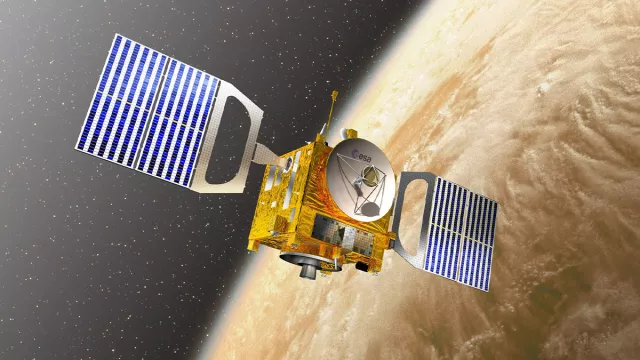From 2006 to 2014, Europe’s Venus Express spacecraft orbited Venus to probe its atmosphere and detect any signs of volcanic and seismic activity. The data beamed back have given planetologists a clearer picture of a planet that, until now, had remained poorly understood.
Key information
Key figures
- 28 November 2014: Contact with spacecraft lost and end of mission
- 19 November 2010: ESA extends mission to 31 December 2014
- 2 October 2009: ESA extends mission to 31 December 2012
- 9 November 2005: Venus Express launched by Soyuz-FG-Fregat
- April 2004: Spacecraft integration
- July 2001: Venus Express project kicks off
- March 2001: ESA decides to pursue project based on architecture of Mars Express spacecraft
Key milestones
- 28 November 2014: Contact with spacecraft lost and end of mission
- 19 November 2010: ESA extends mission to 31 December 2014
- 2 October 2009: ESA extends mission to 31 December 2012
- 9 November 2005: Venus Express launched by Soyuz-FG-Fregat
- April 2004: Spacecraft integration
- July 2001: Venus Express project kicks off
- March 2001: ESA decides to pursue project based on architecture of Mars Express spacecraft
Project in brief
Although close to Earth, Venus is a planet still shrouded in mystery. To get behind the veil of its thick atmosphere, the Venus Express spacecraft was launched by the European Space Agency (ESA) in November 2005 and entered orbit around the planet in April 2006. Its prime mission was to analyse the planet’s atmosphere to determine its composition and dynamics, and to look for signs of volcanic or even seismic activity. These measurements could ultimately tell us why Venus, where surface temperatures are a scorching 460°C, turned out so different to Earth. Venus Express has obtained a number of important results, for example detecting sulphur dioxide in the upper atmosphere, the reason for the layer of sulphuric acid clouds blanketing Venus, and confirming the existence of a double cloud vortex above its southern pole.
To acquire these measurements, Venus Express carried seven instruments, among them VIRTIS (Visible and InfraRed Thermal Imaging Spectrometer), SPICAV (SPectroscopy for the Investigation of the Characteristics of the Atmosphere of Venus) and Aspera-4 (Analyzer of Space Plasmas and Energetic Atoms), developed respectively by the LESIA space and astrophysics instrumentation research laboratory in Meudon, the LATMOS atmospheres, environments and space observations laboratory in Guyancourt and the IRAP astrophysics and planetology research institute in Toulouse.
CNES’s role
CNES provided support to the French laboratories involved in the mission during development of the instruments and also accompanied them throughout the data-collection phase.
Contacts
Solar System Planets and Small Bodies subject matter expert
Francis Rocard
E-mail: francis.rocard at cnes.fr


